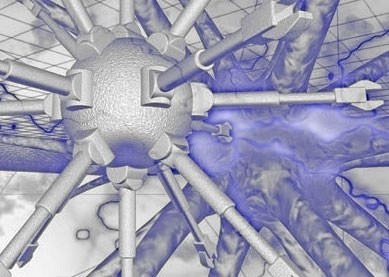Nanoscience and Nanotechnology
José
María PITARKE, Director of CIC nanoGUNE and Professor of Condensed
Matter Physics at UPV/EHU
Igor
CAMPILLO, Projects Manager, CIC nanoGUNE
Itzulpena euskaraz
The term nanotechnology was first coined in 1974 by Tokyo Science University professor Norio Taniguchi, who used it to describe the extension of traditional silicon machining down into regions smaller than one micron. A now more generally accepted definition of nanotechnology is the engineering and fabrication of objects with features smaller than 100 nanometers, i.e., one-tenth of a micron. One micron is a millionth of a meter, whereas one nanometer goes further below to a thousand of a micron, which represents something really tiny as compared to the usual objects we can resolve with the naked eye. One nanometer is about the size of six carbon atoms or ten hydrogen atoms aligned; it is also half the diameter of the DNA helix. These objects are far beyond the resolution power of conventional optical microscopes and one can only image them by the use of powerful electron microscopes and scanning probe microscopes.

Objects are usually labelled as nano when at least one of their dimensions is larger than an atom (about 0,1 nm), but sufficiently small to exhibit significantly different properties to the ones appearing in the micro- and macroscale (above about 100 nm). In this ‘nanoscale’, the materials properties change due to quantum confinement as well as through the increasing influence of surfaces. In fact, it is usually said that ‘small is different’. This claim means that a new phenomenology arises at the nanoscale that is not scalable from what happens at upper scales, i.e., it is not enough to look at the way physical systems behave on the large scale to predict what will happen when one goes to levels of only a few atoms in size. For example, crystallites have different mechanical properties and inert metals, like gold, may exhibit remarkable catalytic activity. In this size regime, the chemical, mechanical, or electrical processes are not separable as in larger size regimes. Furthermore, we are in the natural size of key biological components and much can be learnt from biological processes to engineer materials properties. In order to grasp the full implications of operating at the nanoscale, a real interdisciplinary effort must be made by converging the classical disciplines of Physics, Chemistry, Biology and Materials Science and Engineering. That is how nanoscience emerges as the interdisciplinary study of the phenomena and manipulation of matter at the nanometer scale. Therefore, the nanoscale imposes a scientific challenge and serves as the basis for a nanotechnology that is expected to achieve further industrially realizable outputs and societal benefits.
It is today accepted that nanoscience and nanotechnology can serve as an enabling platform and disruptive paradigm to develop breakthrough solutions for major technological challenges. In this way, nanotechnology is expected to play a critical role as an enabling technology for both traditional industry sectors and emerging high-growth sectors. Therefore, nanotechnology has immense potential to generate economic growth, because of its profound expected impact on a wide spectrum of industries. Along these lines, the Department of Industry, Commerce and Tourism of the Basque Government is launching the so-called “nanoBASK2015” Strategy, an initiative aimed at promoting nanotechnology as an enabling tool that should increase the competitiveness of the Basque industry. The nanoBASK2015 Strategy will provide a sustained funding over the next years with the aim of making the Basque Country an international benchmark in the research and business development of nanoscience and nanotechnology.
The creation of the Cooperative Research Center (CIC) nanoGUNE is a key initiative within the nanoBASK2015 Strategy. CIC nanoGUNE is a new research center, with legal personality, created in February 2006 with the mission of addressing world-class nanoscience research for the competitive growth of the Basque Country. As well as other cooperative research centers, nanoGUNE is composed of a newly created physical section, the core of the center, and what we sometimes call virtual section. While the newly created physical section is oriented to open new areas of strategic research, in the virtual section cooperation will be fostered among existing research groups at universities, technological centers, and other institutions in the Basque Country. nanoGUNE’s activities will include not only world-class research in nanoscience and nanotechnology, but also the promotion of high-level training, communication and outreach, international cooperation, technology transfer, and the development of a new industrial sector in the Basque Country that would be enabled by nanotechnology. nanoGUNE’s research activity will be initially implemented within the following major areas of strategic research: (I) nanoelectronic properties and devices, (II) nanophotonics, (III) synthesis, functionalization, and processing of nanomaterials, (IV) nanofabrication and nanostructure assembly, and (V) biofunctional nanostructures and nanobiotechnology. In two or three years nanoGUNE should have around 35 researchers; by 2015 the number of researchers might approach 80-100.
Progress in nanoscience research is only possible if one can actually fabricate nanoscale materials and measure their properties on the nanometer scale and with sufficiently high sensitivity. Thus, one key challenge is to build a unique infrastructure, free of electromagnetic interference (EMI), with an ultra-low level of vibration and acoustical noise and ultra-clean rooms available. In order to achieve this goal and host state-of-the-art facilities for nanoscience research, a complex working team has been put together, including vibration, EMI and clean-room consultants. The nanoGUNE building, located at the Campus of Ibaeta of the University of the Basque Country (UPV/EHU) in San Sebastian, is expected to be finished towards the end of the summer 2008.
euskonews@euskonews.com
